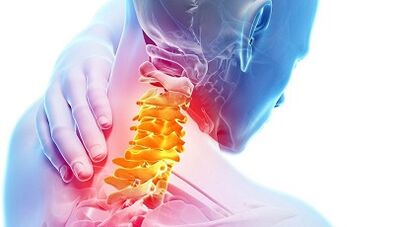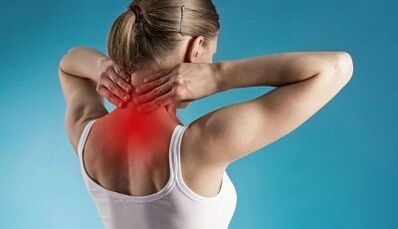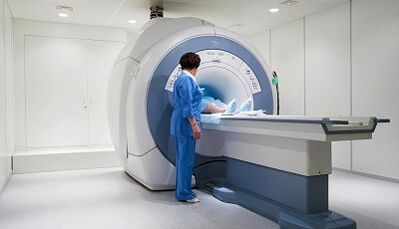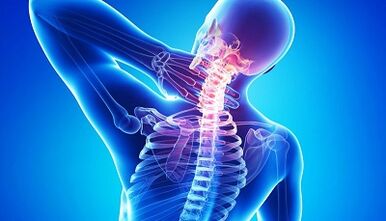Among all the violations of the musculoskeletal system, the second place in terms of prevalence is occupied by the osteochondosis of the cervical column.The symptoms and treatment of the disease are determined by the stage of its development, so it is so important not to lose the signs of an imminent disorder.
Causes and symptoms of osteochondosis of the cervical column

Osteochondrosis is called dystrophic changes in the joint cartilage against the background of the lesion of the intervertebral discs.
The cervical osteocondrosis is characterized by the pathological destruction of the fabric of the cartilage of the vertebrae that support the head.
Very often, the disease is diagnosed in people aged 30 to 40.In developed countries, this or another degree of cervical osteochondrosis is diagnosed in 80% of the population.
The neck is considered the most mobile spine.At the same time, there is no insufficient amount of muscles around the neck that can compensate for the loads on the spine.Therefore, most of the loads falls on the intervertebral discs that play the role of shock absorption.
Consequently, the records consume, dry and flatten, the osteochondrosis develops.
The reasons that contribute to the appearance of the pathology are found not only in anatomy, but also in human behavior:
- Sowing and static and sedentary work - on the computer, guiding a car, in the office;
- Excess weight;
- Great physical effort;
- smoke;
- improper nutrition;
- weak physical form;
- spinal lesions.
Further provocative factors in the development of osteochdrosis are: flat feet, soft mattresses and cushions, the habit of wearing a bag on the shoulder, hypothermia and stress.
How the disease is manifested
At the beginning of the disease on its development, only the flow of the neck, which is usually not paid attention.With the progress of the pathology, the number and intensity of the manifestations increase.
Characteristic symptoms of cervical osteocondrosis occur:
- pain in the back of the head, at the base of the neck, giving in the limbs;
- crunch and pain when turning your head;
- numbness or tingling of the areas between the shoulder blades and the base of the neck, burning, a sense of discomfort and rigidity;
- headache, migraine, dizziness;
- Weakness, fatigue.
Secondary symptoms are considered a decrease in vision, hearing, memory problems, sleep disorders, inattention, distraction, pressure.
Syndromes caused by osteochondosis of the cervical column

Doctors classify the signs of osteochondrial processes as syndromes associated with a certain type of spine.
Stenosis.It develops against the background of the intervertebral discs and is accompanied by a violation of blood circulation and the growth of bone tissue.It manifests itself by numbness of the limbs.
Reflected and irrelevant syndrome- A consequence of the compression of the vertebral artery with neck curvature and compromised posture.It manifests itself in serious pain paroxysms in the occipital part with gradual diffusion in the areas around the forehead.
Rook syndrome.It is observed when flattening the spinal roots - the consequences of an hernia.At the same time, sensitivity in the areas concerned is reduced and the motor activity becomes limited.It can be accompanied by the development of vocal defects, snoring, compromised smell, a decrease in the sensitivity of the muscles of the language.
The degree of development of cervical osteochondosis
The complexity of the process process is determined by the state of the octopus nucleus that fills the vertebral space.
The degenerative lesions of the cervical region are conditioned in three phases:
- First.The intervertebral disc is compact.The hooks of the vertebrae of the vertebrae are increasing.The rigidity of the muscles appears, but their mobility does not change.Small edema and pain when turning your head are possible;
- The second.It develops against the background of the progress of the first stage of the disease, if the treatment of the osteocondrosis of the cervical column was absent or performed incorrectly.Intervertebral holes are reduced, the height of the intervertebral discs becomes less because of their flattening.Pinches the nerve roots.The patient feels painful pain;
- The third.The cracks in the fibrous ring surrounding the intervertebral disc lead to the breaking of its capsule and the deformation of muscle tissue.The stability of the fixation of the pulpose nucleus inside the intervertebral disc is violated.Intervertebral hernia develops.It is characterized by acute pain in the neck, numbness of the tongue, edema, limitation of mobility, curvature of the spine.
The correct position of the vertebrae of the cervical region determines the functionality of the visual and auditory nerves, the nose, the lips, the mouth, the throat, the teeth, the facial nerve, the pitchfoot, the brain, the parasimpatic nervous system, the muscles of the neck and the forearm, the thyroid gland, the shoulders.
Diagnostic methods

The exact determination of the cause of the development of osteochdrosis allows you to intentionally influence the disease.The preliminary diagnosis is indicated after the initial examination by the doctor.
The patient's complaints on the nature of pain syndromes are taken into consideration, as well as the information obtained during the examination of the spine in various positions.The study of the cervical compartment allows you to determine the presence of seals and deformations.In addition, attention is paid to the tone of the patient's muscles and motor skills.
Doctors receive complete diagnostic information using studies such as:
- X -ray.The procedure allows you to evaluate the condition of the vertebrae in two projections: straight and lateral.The result is the determination of damage, saline deposits and compact formations;
- Magnetic resonance imagingIt allows you to establish not only any pathologies of the spine, but also the degree of gravity.By means of a magnetic resonance imaging, a doctor can evaluate the state and level of damage to the nerve finals, blood vessels and intervertebral discs;
- Computerized tomography- Digitization of information obtained by irradiation of X -ray.
In the presence of dizziness, a further study on structural change in blood vessels through domorography, angiography and Duplex scan may be necessary.
How to treat cervical osteochondrosis?
After making an accurate and clarified diagnosis the causes of the development of the disease, the neurologist determines how to treat cervical osteochondosis.
The optimal results are brought by complex therapy, which involves the use of different methods.Protocols include drug effects, hardware procedures, exercise therapy and therapeutic massage.
Treatment with medicines

In every single case, the choice of drugs occurs individually.It depends not only on the gravity of the pathology, but also on the specific characteristics of the patient's body.
Foscezioni I was of drug treatment:
- Anti -inflammatory drugs - tablets that relieve pain and inflammation;
- Condroprotectors - drugs that activate the regeneration of the cartilage tissue;
- External use: ointments and gels that stop pain and inflammation;
- A complex of vitamins in support of the body and stimulate its restoration.
In the first phase of the therapeutic effect, it is possible to increase pain syndrome - this is the reaction of the muscle system.To reduce discomfort and improve the results of the pharmacological treatment, physiotherapy procedures are used.
Physiotherapy
Physiotherapy indicates the effect on the cause of the disease using special equipment: electrophoresis, tissue electrical stimulation.The use of low frequency currents improves blood circulation in affected areas, relieves edema and pain and at the same time increases the effectiveness of medical effects.
The minimum hardware treatment course is 10 sessions.
Cervical osteochondosis massage at home
Manual therapy is a productive way to influence the areas affected at home.With the help of the massage, the pinch, the muscle cramps and the pain are eliminated, the blood circulation improves and the compression of the nerve roots is reduced.
Thanks to the massage, the metabolism improves and the fabrics of the spine are restored.
Physical education of the media for osteochondosis of the cervical column
The best method to restore the functionality of the organs of the musculoskeletal system and the prevention of relapse is the physical education of physiotherapy for osteochondosis of the cervical region.The procedures are prescribed after completely relief of pain and inflammatory processes.
The main types of exercise therapy:
- medical gymnastics;
- walk dose;
- lessons on simulators;
- I swim.
In order for the exercises for cervical osteochondrosis to bring the expected results, the lessons must be held under the supervision of competent specialists.
Popular remedies
The complete elimination of cervical osteochondrosis is impossible using traditional medicine methods.On the other hand, the use of popular remedies allows you to improve patient conditions, relieve inflammation, reduce pain and strengthen immunity.
On average, the therapeutic period with cervical osteochondrosis takes up to three months.If the conservative treatment has not brought the expected results, surgery is used.
Why is cervical osteochondosis dangerous?

Pathologies in the neck represent a serious threat to all human health.Since the neck connects the head to the body, in this section of the spine there are all important biological communications: arteries that feed the brain, the nerve channels.
Any changes in the functionality of the cervical region involve the consequences in form:
- Blood circulation and brain nutrition disorders.Consequently, the hypertension, the pathology of the respiratory system and the cardiovascular system, VSD, compromised coordination, hearing problems, vision and language;
- Vertebrate artery syndrome.The pathology develops against the background of squeezing a ship that feeds the brain and an oblong brain.The development of cervical osteochondosis can cause ischemia and stroke;
- Radicolopathy - Damage to the nerve roots, the growth of bone tissue on the vertebrae, following which a partial or complete loss of mobility occurs.
The most dangerous compression of the spinal cord, which is located inside the spine.This pathology leads to a breaking of the spinal cord shell and causes paralysis.In particularly serious cases, cervical osteochondrosis ends fatal.
Prevention
Even after a complete recovery, the disorder can return again if the patient does not see his lifestyle again: the method of work and rest, habits, food.
As preventive measures, neurologists recommend paying attention to the following points:
- The rigidity of the mattress.The ideal option is a orthopedic mattress and a low pillow;
- A visit to the sauna is necessary for the complete relaxation and removal of muscle cramps;
- The daily hot shower is a good tool to improve blood circulation in the neck;
- Swim, walking on foot, stimulates blood circulation, strengthens the muscles of the spine;
- Proper nutrition is the refusal of products that slow down the metabolism: fat, fried, sweet, smoked, flour and alcohol.We recommend dishes with gelatin, dairy products -caseari, walnuts, vegetables, white meat, seafood.

In everyday life, a great physical effort should be avoided, acute turns of the head, prolonged seat or being in a static position.In addition, it is desirable to use chairs that provide support for the head and back.
Position of active life, healthy food and morning exercises are simple but effective ways to avoid most diseases and live a long life without pain and discomfort.



















